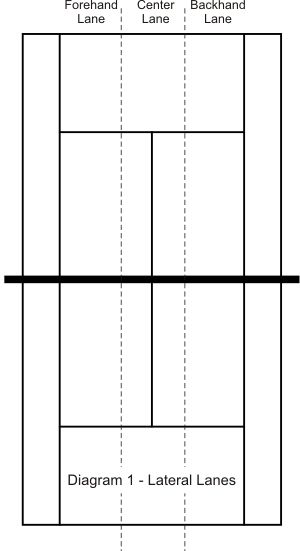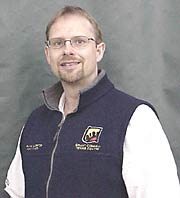|
TennisOne Lessons Dominating the Center Lane Game-Based Situation Training Wayne Elderton Situation Training (ST) is a practical application of the international coaching trend called the Game-based approach. ST equips players with the tactics and techniques required for successful play. In our last installment (Dominating the backhand diagonal), we looked at the keys to take charge when rallying in a backhand crosscourt exchange. Controlling the diagonals (forehand and backhand) will often lead to a weaker ball in the center. In this article, we will look at how to get and keep the advantage when rallying in the center.
The Story You're a 3.5-5.0 level player. You receive a strong serve and all you can do is put it back in the middle of the opponent's court. Fortunately, you have kept the ball deep. Your opponent, having no angles, puts it back to the middle of your court. You are now in a center exchange. What can you do to gain control of the rally? How do you deal with the lack of angles you are faced with? As much as many players are taught, and try to, avoid hitting to the center, the nature and geometry of the game draws the ball there often. Even at the pro level, center rallies are common (and even intentionally created). In clip #1, we see David Ferrer (close side) against Rafael Nadal. Play the clip a couple of times and notice how the players hit for the center at opportune times. Both players exploited the center very well.
Location, Location, Location To create a common reference, let's define what we mean when referring to the different locations on the court. We can divide the court into 3 lateral ‘‘Lanes” (you can divide it into 5, 6, or 10 if you want, but let's use 3 to keep things simple). The Forehand and Backhand Lanes are referenced to the player. For example, if you are a right-hander, your Forehand Lane is to your right. A ball sent crosscourt to another right-hander would land in their Forehand Lane. That same crosscourt ball sent to a left-handed player would land in their Backhand Lane. The area between the side lanes would be the center Lane (see diagram #1). For you detail oriented players, don't worry about their exact width since it is not critical to our discussion. Tactics for the center Exchange “Pin” the center In a previous article, I defined a “Pin” shot (see, “Dominating the Forehand Diagonal”). Simply put, a Pin is a shot that is rising as it gets to the opponent and is strong enough to keep them neutral. It is only in their ‘strike zone' (between waist and armpit height) for a very short time. An opponent could try to attack a good pin however, to do so would mean a low percentage shot (the opponent may hit some winners but would always miss more than they get during the course of a match). When you receive a deep shot in your center Lane, the highest percentage option is to pin your opponent into their deep center Lane. In professional tennis, you will see great ralliers (typically clay court players) engage in a pin battle in the center until one player cracks and sends a weaker or shorter ball. Watch Clip #2 and see how Ferrer (close side) receives Nadal's center “T” serve and goes for the center. This entices Nadal to respond up the center. Ferrer pounds the center again with his backhand and sets-up a forehand.
Receiving a very deep ball in the center If your opponent has placed a ball very deep in your center Lane, responding with a “moonball” back to their center lane may be the best option. A "moonball" is a shot hit with increased height and topspin. To make it easier on yourself, use your forehand (if your backhand is better equipped to send a higher/deeper shot, use that). Responding from so deep in your center lane with any other shot will be a risk. By putting it back higher and deeper, you will give your opponent no angles and keep the ball out of their hitting zone as well. Watch Clip #3 as Coria (far side) receives a deep center ball from Roddick. He then sends the Moonball to keep Roddick well back in the court and prevent him from attacking. Patience is a Virtue Being in a pin battle in the center Lane is a bit of a waiting game. The good news is, the typical 3.5-5.0 player will give up a weaker or shorter ball, within 2-4 shots. Your job is to practice this situation so you are not the player who cracks first.
Remember, playing smart doesn't mean not being aggressive, just constructing the best opportunities to play aggressively and with a high percentage (an unbeatable combination). Your job is to hang in there a couple of shots until an opportunity to do more presents itself. Add pressure by capitalizing on any opportunity There are a couple of situations that are opportunities to gain advantage in the center pin exchange. Practicing identifying, and taking charge in these situations will gain you many points. Here are the situations to look for and how to respond:
If you can show an opponent you will jump on these opportunities, it has the added benefit of pressuring their pin shots. Basically, the message you send is, “If you hit a high quality pin, I will accept that and pin back. We will at worst be equal. If your pin isn't deep, strong, has enough spin, or floats high, I will take charge.” By pressuring their pin shots, you will avoid any longer ‘push' rallies that may occur. Their only option is to maintain a high quality rally (which most can't do) or, go for risky shots. Here is our shot Situation Chart for the center Lane ball:
Go back up to the top of the article and review Clip #1 with your new-found understanding of what to do in the center Lane exchange. Take note of the combination of Pins, when they use their forehand, and what they do with higher or shorter balls.
Drilling This is a baseline game (no coming to net). Start with both players in the center Lane. One player feeds the first ball high and deep to the partner's center lane and the battle begins! Scoring: Points ending in the center Lane are worth one (e.g. unforced error on a center pin shot). Points ending in a side lane are worth 2. For example, anyone who takes advantage of a shorter, weaker, or higher ball, and puts it to the side lane gets 2 points if they win. Each player takes turns starting the point. Your comments are welcome. Let us know what you think about Wayne Elderton's article by emailing us here at TennisOne.
|
||||||||||||||||||||||||||||||


 Wayne Elderton
Wayne Elderton